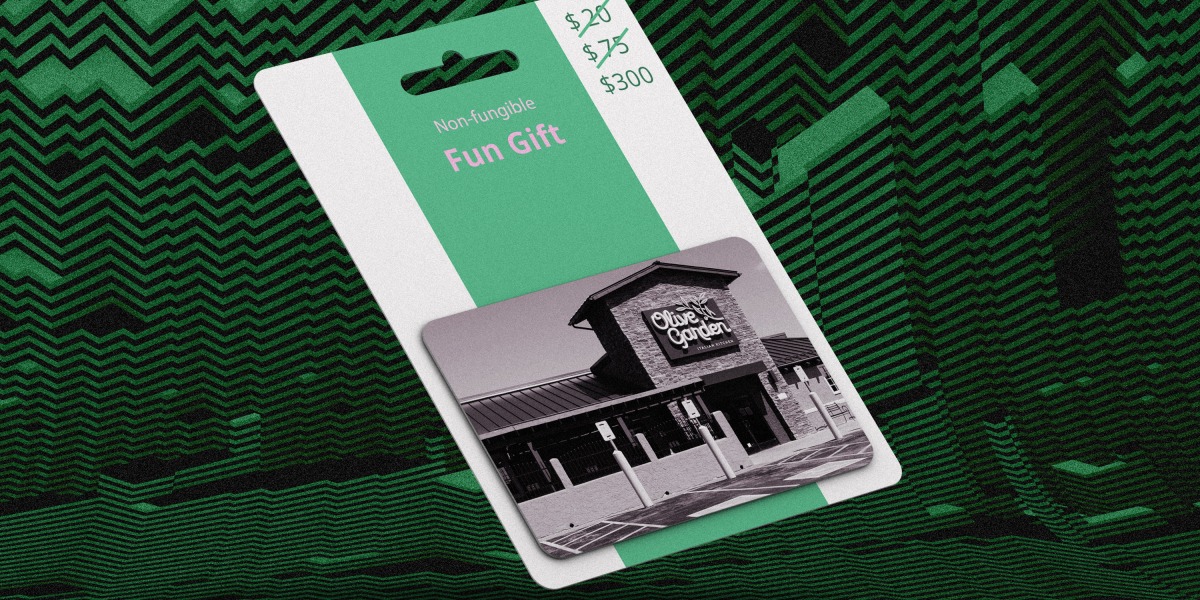Our newest issue spells out what you need to know about the dizzying world of digital money.
Money is weird now.
When we were settling in on the theme for our May/June issue, I decided to buy an NFT of an Olive Garden for my friend Katie, who really loves Olive Garden. It was also an attempt to try to better understand NFTs. Each of the “Non-Fungible Olive Gardens,” really just a photo of a restaurant, was minted for $19.99 and listed on the NFT trading platform OpenSea—the amount tethered to the price of a Tour of Italy menu item. The NFTs were not associated with the actual Olive Garden restaurant chain (though each one corresponds to a real-life location). But still, it seemed like a bargain!
I wanted to plunk down my $20, but OpenSea didn’t accept credit cards. I would need to buy some of the cryptocurrency Ether to complete the transaction. Okay! I’m game. Ether in hand (or wallet, more precisely), I went back to OpenSea and tried to make a purchase. Except by the time I was ready, those initial drops had already seemingly sold out. The price had gone up. Way up. Secondary sellers, who perhaps saw the same Twitter threads I’d seen, were now trying to flip their OG NFTs. With grim resignation, I bought some more Ether and tried again.
That’s when I discovered gas fees, a service fee charged by miners to verify transactions. Being cheap, I lowballed. My transaction never went through. The price of Olive Gardens was still going up. I tried again, paying market rate this time. Success! Katie was going to be so happy.
Except … have you ever tried giving someone an NFT? I needed to pay even more in gas fees to make the transfer. All in, the jokey purchase I had initially thought would cost me $20, and later reassessed to maybe $75, ultimately set me back nearly 300 bucks.
But hey, my friend Katie was now the owner, kind of, of a JPEG of a photo of an Olive Garden in a mall in Louisville, Kentucky, on the Ethereum blockchain. What a great gift!
That is, it was a great gift until just over a week later, when the real Olive Garden’s attorneys sent OpenSea a takedown notice, and all those non-fungible Olive Gardens vanished into the, uh, ether. Poof.
Like I said, money is weird now. And so this issue dives into the way technology is shaping our financial future.
Whether it’s a biometric-based universal cryptocurrency meant to underpin Web3, cities built by Bitcoin, digital currencies that are replacing cash, or the way iBuying is transforming the housing market, technology is fundamentally changing the ways we buy, spend, and save money. Even the way we gamble.
We hope you enjoy this issue, and that it reveals something new to you about the present that helps you better understand and prepare for the future. Even if that’s just budgeting in your gas fees in advance.
Correction: An earlier version of this story cited a copyright notice, it was actually a trademark infringement notice.
This story was part of our May/June 2022 issue.
One of the world’s biggest blockchains is testing a new way to approve transactions. The move has been many years in the making but doesn’t come without risks.
A new class of crypto investors have bold plans to rebuild society from scratch. But their pet projects risk repeating the region’s long history of corporate colonialism.
The crypto industry is investing heavily in getting more people to buy in. That doesn't mean you have to.
When a cryptocurrency’s value is theoretical, what happens if people quit believing?
Discover special offers, top stories, upcoming events, and more.
Thank you for submitting your email!
It looks like something went wrong.
We’re having trouble saving your preferences. Try refreshing this page and updating them one more time. If you continue to get this message, reach out to us at customer-service@technologyreview.com with a list of newsletters you’d like to receive.
Our in-depth reporting reveals what’s going on now to prepare you for what’s coming next.
Subscribe to support our journalism.
© 2022 MIT Technology Review

